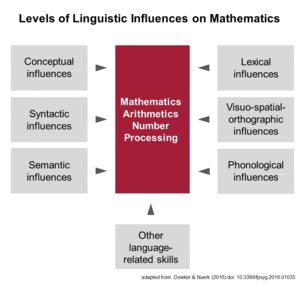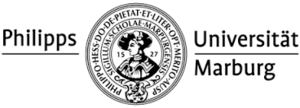Linguistic Influences on Numerical Cognition: A cross-cultural investigation using natural specificities of Polish and German languages (LingNumCog)
Go to:
- Knowledge Base
- Project-related Outputs
- Special Issue
- Collaborators
- External Advisory Committee
- Workshops
- Contact
Linguistic influences on numerical cognition have been neglected for years and it has been argued that central semantic number processing occurs largely without linguistic influences. However, the last years have seen a surge of studies showing that different linguistic aspects exert major influence on virtually all domains of numerical processing. Here we focus on the grammatical attributes of number words, which have never been studied before beyond infant age. The project is the first to make use of the natural specificities of the Polish and German (and in some control studies English) languages in such a translingual approach.
Differences in grammatical numbers between Polish and German
In contrast to the transparent rules in German (1 singular, all other numbers plural), grammatical attributes of number words in Polish are much more complex. For instance, verb form changes with number: singular for 1, plural from 2-4, singular again from 5-9; singular for 21, 31 etc., plural for 22-24, 32-34 etc., singular for 25-29, 35-39 etc. Based on early grammatical effects in infant literature and because other linguistic influences persist into adulthood, we hypothesize that above irregularities also influence numerical cognition. The first research line systematically examines this hypothesis for single-digit numbers in preschool children, elementary school children, and adults.
Inverted lexical composition for multi-digit numbers in German
The second research line focuses on grammatical influence on multi-digit numbers, for which German has a particular irregularity as regards the lexical composition of number words: The order of its constituent elements is inverted (“one-and-twenty”). Therefore, all grammatical aspects influencing multi-digit number processing will be examined in Polish, English and German to dissociate grammatical from lexical linguistic influences.
Methodological approach
Throughout the whole project, all translingual studies are conducted exactly parallelized in the different countries. Besides behavioral data (RT and errors), we included advanced methods like fNIRS and eye-tracking for the first time in a such a translingual setting in numerical cognition to better explore underlying (neuro-)cognitive processes driving linguistic differences. We believe that such basic research will considerably improve our understanding of the impetuses of numerical development and cognition.
Basic principle
Our research approach is guided by weak version of linguistic relativity. Namely, we assume that language influences cognition (in our case the number processing) but does not determine it.
Below we present the overview of possible linguistic influences on number processing (adapted from Dowker & Nuerk, 2016).

Conceptual influences
The linguistic markedness concept suggests that for (almost) every adjective pair, a ground (unmarked) form and a derived (marked) form exist (e.g. efficient and inefficient; marked by “in”). For number parity, the ground form is even, and the derived - odd. This is also the case of German (gerade versus ungerade) and Polish (parzyste versus nieparzyste) languages. Also many would be a ground form, and few – a derived form. Markedness have been repeatedly shown to influence number processing. We consider it as a “conceptual” level of influence because markedness is assumed to be involved in the conceptual preparation of lexical concepts (Levelt et al., 1999).
Syntactic influences
The grammatical number is an instance of linguistic influence on mathematics on a syntactic level. Languages differ significantly in their use of grammatical number (e.g. in English singular form goes along with number 1 and plural for numbers 2 and greater whereas in some languages like Slovenian there is a separate grammatical number for two). The influence of the grammatical number has been shown in a grammatical SNARC effect (Roettger & Domahs, 2014) and in the development of number concepts in children (Sarnecka, 2016).
Semantic influences
Word meanings also influence numerical processing. Daroczy et al. (2015) reviewed text problems and found that numerical properties and semantic properties are often interacting. For instance, addition is more associated with words like “more” and “buy” whereas subtraction is more associated with words like “less” and “sell”.
Lexical influences
Two types of lexical properties have been shown to influence numerical cognition: The first involves the inversion property of some languages which means an inversion of units and decades (“one-and-twenty” for 21 e.g. in German). The second one involves power transparency. Some languages are extremely transparent with respect to the power of a given number (e.g. “ten-two” for 12 in Chinese). The power of each two-digit number can be derived directly from the number word. Both these effects have been shown to influence both number acquisition in children (and typical errors children make) as well as number processing in adults.
Visuo-spatial-orthographic influences
Visual-spatial-orthographic influences mostly involve the reading/writing direction of a given script. Usually, space-number relations are associated with the dominant reading/writing direction. Visual-spatial-orthographic influences haven been shown for both horizontal and vertical dimensions.
Phonological influences
Jordan et al. (2015) examined phonological skills in children with difficulties in reading, mathematics or both and found minor influences of phonology on mathematics. Pixner et al. (2016) examined children with cochlear implants, who usually have phonological language deficits. They found general deficits in such children in multiplication, subtraction and number line estimation but specific deficits in (verbally mediated) place-value manipulation.
Other language related skills: verbal working memory and other cognitive skills
Verbal working memory (WM) is associated with complex arithmetic (Ashcraft & Stazyk, 1981). Soltanlou et al. (2016) investigated whether verbal or spatial working memory influences multiplication skill most strongly. They observed an age-related shift from verbal WM to spatial WM influences over time.
Our studies result from close collaboration between four institutions: University of Tuebingen, University of Warsaw, Philipps-University Marburg and University of York.




Our project is funded by “Beethoven” – Polish-German Funding Initiative in the Humanities and Social Sciences, co-founded by Deutsche Forschungsgemeinschaft (DFG) and Narodowe Cenrtum Nauki (NCN).
![]()

